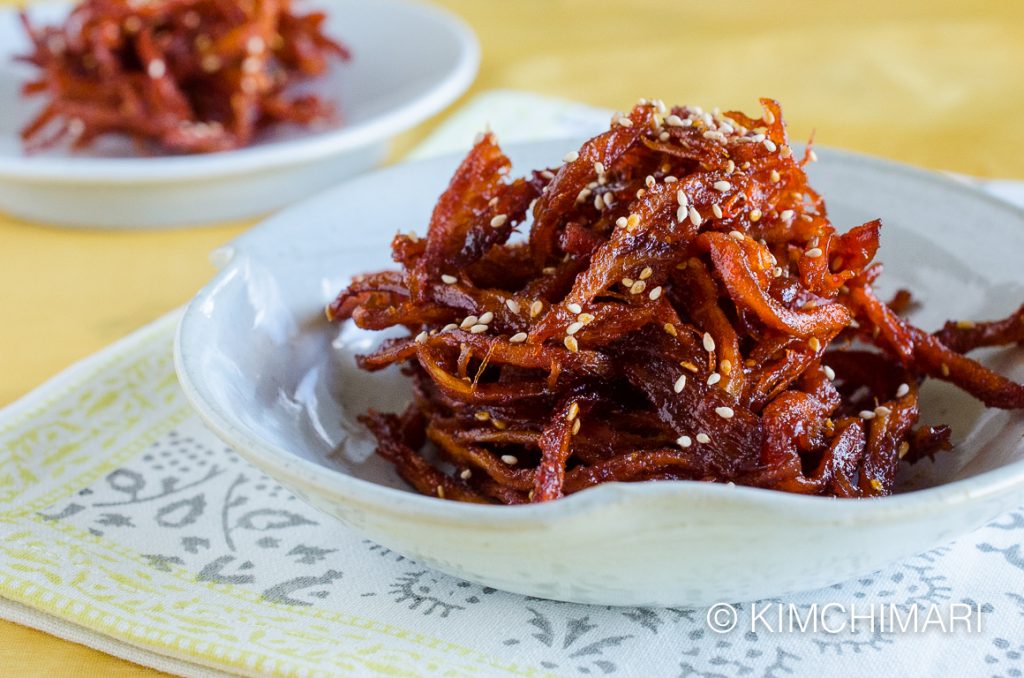
Korean Spicy Dried Squid Recipe or Ojingeochae Muchim (오징어채 무침) is one of the most popular banchan in Korean cuisine. Especially in dosiraks (Korean bento lunchbox). It is also my daughter’s most favorite side dish. Recently, my good friend and best blog follower Judith asked me to post this spicy dried squid recipe. She told me that she wanted to make ojingeochae muchim but said if I was going to post a recipe soon, she was willing to WAIT even though she already bought the ojingeochae. Well, Judith, although a bit late, this is for you. Oh and this is also for my daughter for later, when she decides to make it. 🙂
Ojingeochae Muchim is sometimes also called Ojingeochae Bokkeum (오징어채 볶음). For your reference, the difference between muchim and bokkeum is that muchim means to toss and coat with seasoning and bokkeum means sautéed or pan-fried. And I guess it is called by both names because this spicy dried squid recipe includes both cooking methods – it is first tossed in gochujang sauce (muchim) and then quickly pan-fried (bokkeum). Ojingeochae (오징어채) literally means ‘julienned squid’ but it somehow always refers to dried squid that is seasoned and cut into thin strips not fresh ones.
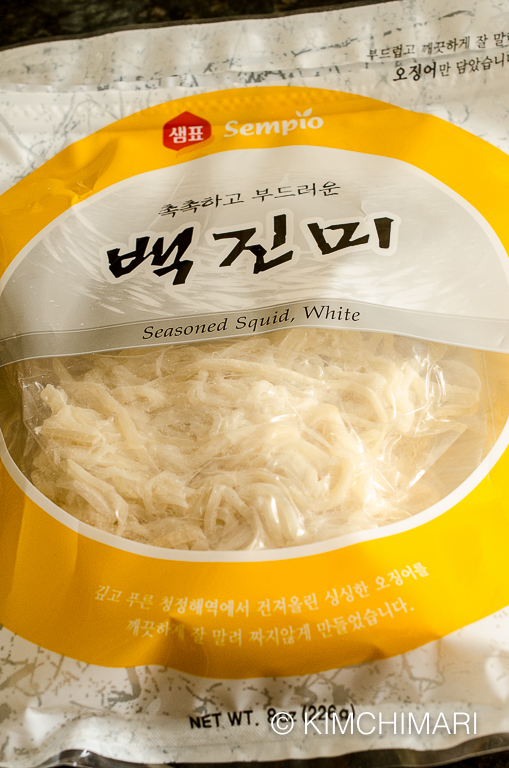
Note that these dried squid strips already come seasoned in packages which is great to eat straight from the bag as snacks or with beer! But it often contain MSG, so beware of that if you are allergic to MSG.
When I think back, I think about how, many years ago when I was in school, many of my American friends gave me puzzling looks and questions when I talked about Koreans eating squid. They would say things like –
“What??? You eat squid?? Those sea creatures that look slimy with many legs??? You really eat them??”
But now, thanks to the Italians (calamari) and Japanese (ika), most people seem to be quite comfortable with eating squid. BTW, calamari and squid are actually different – see my post on Ojingeo Bokkeum for more info on nutrition and a recipe using fresh squid.
Still, dried squid is not as well known in the US. It is kind of an acquired taste because the dried squid has a stronger and more concentrated flavor than fresh squids. But once you get over the stinky smell, they are sooo good. The dried squid also goes great with beer so try that sometime!!
Because dried squid is quite hard and chewy, Korean moms (my generation) sometimes gave a strip of dried squid to their babies who were teething (just like you give rawhide to puppies to chew HAHAHA). The salty umami flavor and the texture keeps them entertained for quite a while. Of course, you do have to make sure they don’t choke on it so they have to be constantly watched and it should be taken away once they start to look soft and they can actually bite it off. I’m NOT recommending this at all for today’s ever-so-careful young parents but I’m just saying that’s what our moms did in the old days when they had 5+ kids…
Now, on to our recipe –
Korean Spicy Dried Squid Recipe (Ojingeochae Muchim)
Servings 2 (4 oz) Time: 10 min Difficulty: Easy
Ingredients
- 4 oz (110g) dried squid strips (ojingeochae)
- Sauce for Ojingeochae Muchim
- 1 Tbs gochujang
- 1 Tbs rice wine (mirin)
- 2~3 tsp gochukaru (korean red chili powder)
- 2 tsp soy sauce (jin ganjang – kikkoman will do)
- 1 tsp sugar
- 1/2 tsp garlic powder
- 1 Tbs maple syrup
- 1 tsp mayonnaise
- sesame seeds
- Boil hot water (about 2 cups). Put squid in a metal colander or sieve. Gently pour hot water over the dried squid strips. This process softens the squid but also removes some of the seasoning, making it less salty. Skip this step if you prefer chewy ojingeochae. If you do skip, also remember to use less soy sauce.
Dried squid before blanching for Ojingeochae Muchim Dried squid after it is blanched in hot water - Mix gochujang, gochukaru, sake, soy sauce, sugar, garlic powder and maple syrup to make seasoning for dried squid recipe.
Seasoning for Dried Squid Recipe - Heat pan on medium low heat and simmer the seasoning sauce for 2 minutes. Stir a few times. We don’t want to reduce the sauce, just cook the raw taste out of it.
Seasoning sauce in pan for dried squid - Turn heat to LOW. Toss and mix dried squid strips with the sauce. Mix until squid strips are evenly coated. Turn OFF heat.
Dried squid in spicy sauce for ojingeochae muchim - Mix in 1 tsp of mayonnaise. Also, if you are using corn syrup, this time is when you will be adding it also. Adding mayonnaise is optional. It does kind of round out the seasoning and also keeps everything more moist but flavor wise, it is really not that noticeable in my opinion.
- Sprinkle lots of sesame seeds on top and that’s it!
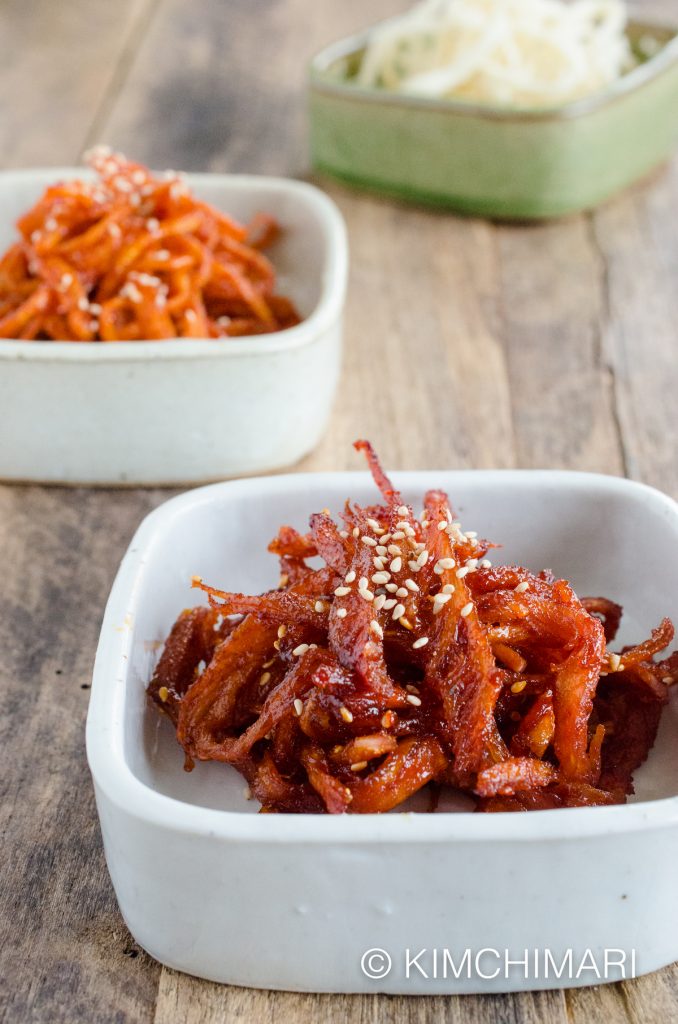
Korean Spicy Dried Squid Recipe (Ojingeochae Muchim)
Ingredients
- 4 oz dried squid strips (ojingeochae)
Sauce
- 1 Tbsp gochujang
- 2 tsp red chili powder (gochukaru)
- 2 tsp soy sauce (jin ganjang – kikkoman will do)
- 1 tsp sugar
- 1/2 tsp garlic powder
- 1 Tbsp maple syrup
- 1 tsp mayonnaise
- 1 pinch sesame seeds
- 1 Tbsp cooking sake (mirin is ok but will be sweeter)
Instructions
- Boil hot water (about 2 cups). Put squid in a metal colander or sieve. Gently pour hot water over the dried squid strips. This process softens the squid but also removes some of the seasoning, making it less salty. Skip this step if you prefer chewy ojingeochae. If you do skip, also remember to use less soy sauce.
- Mix gochujang, gochukaru, sake, soy sauce, sugar, garlic powder and maple syrup to make seasoning for dried squid recipe.
- Heat pan on medium low heat and simmer the seasoning sauce for 2 minutes. Stir a few times. We don’t want to reduce the sauce, just cook the raw taste out of it.
- Turn heat to LOW. Toss and mix dried squid strips with the sauce. Mix until squid strips are evenly coated. Turn OFF heat.
- Mix in 1 tsp of mayonnaise.
- Sprinkle lots of sesame seeds on top and that’s it!
Nutrition Information:
Notes
- Most spicy Korean dried squid recipes and many Korean side dish recipes use corn syrup. Most recipes use it because that is what Koreans have used for many years. Also they say you need to use corn syrup because it adds a sheen to it. It is also cheap. But I stopped using it for health reasons and I find maple syrup does the job wonderfully. Corn syrup is also problematic because adding it at the wrong time can make everything become rock hard. So if you are going to use corn syrup in Korean side dishes, always add it at the very end and turn OFF heat right after or just add after heat is off. On the other hand, maple syrup never hardens, no matter when you add it so that’s also a plus.
- You can store ojingeochae muchim in the fridge and it will store for many days, even weeks.
- Use ojingeochae muchim inside rice balls or kimbap. They make great stuffing for them.
Well, hope you get to make some – it will be a great banchan to have anytime!
XOXO,❤️
JinJoo
PS – I have added ojingeochae to my store if you need to buy online. It’s under Dried Foods category.
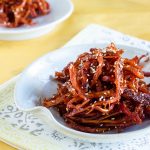
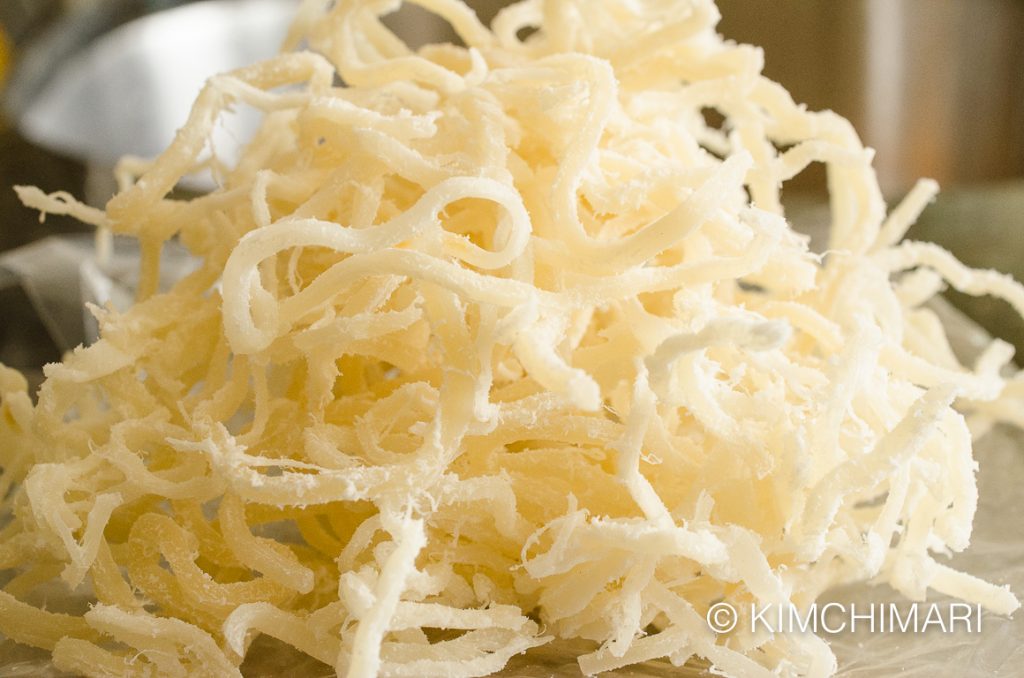

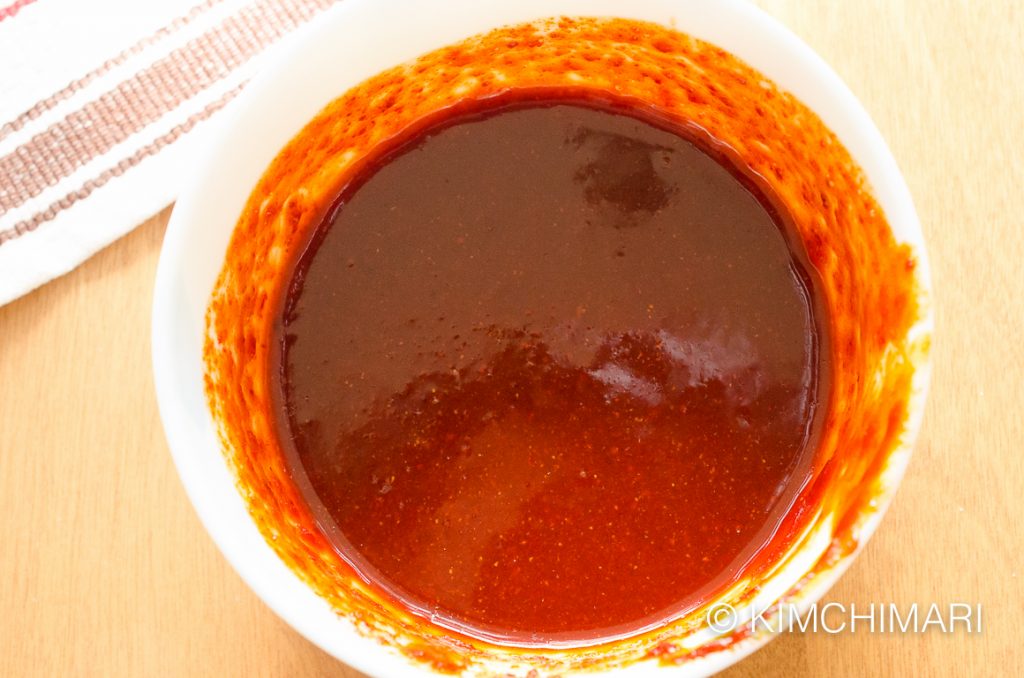
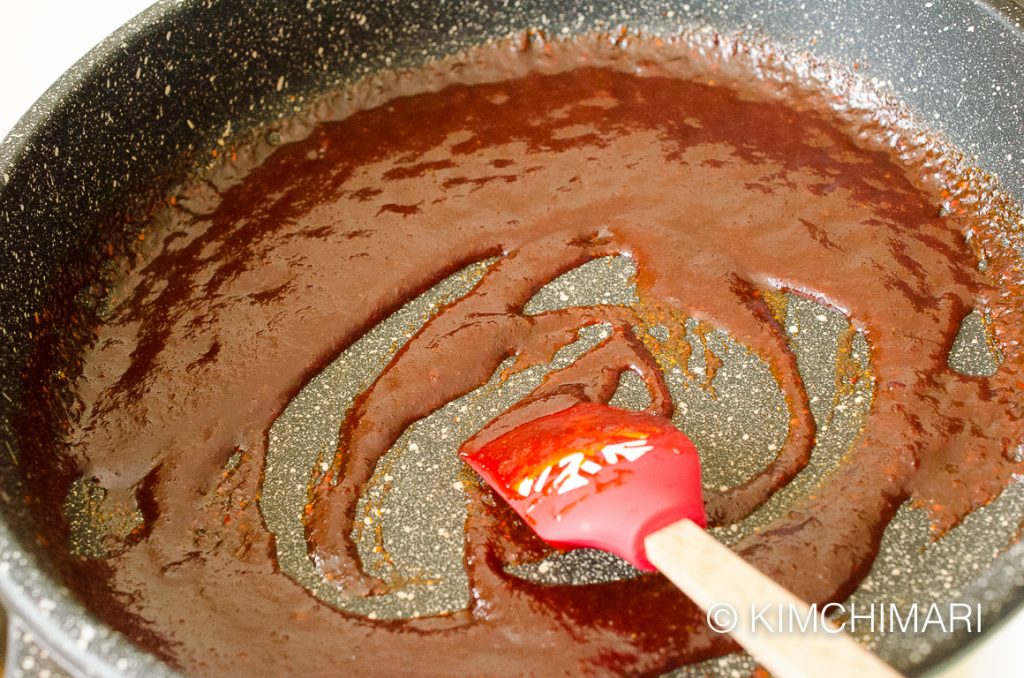


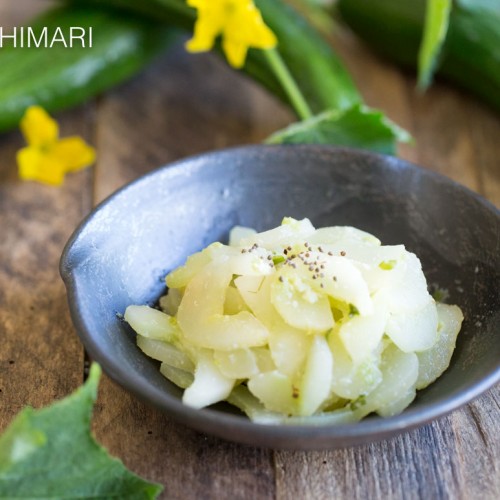
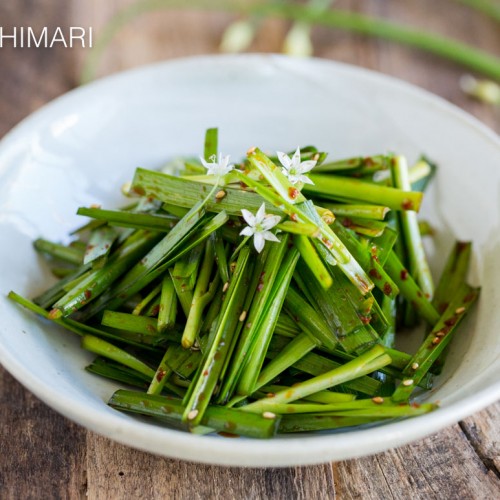
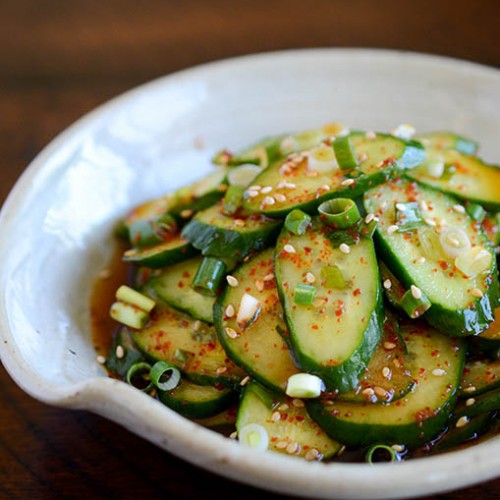
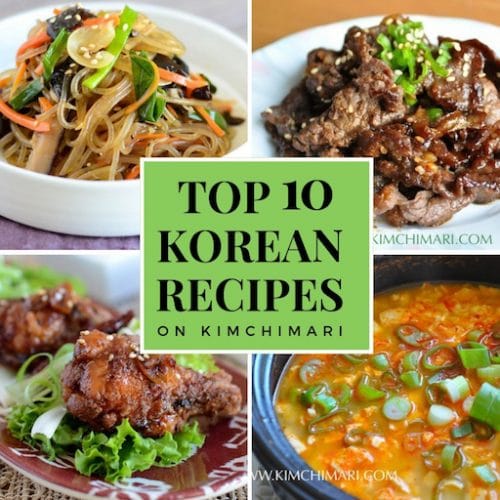
















JinJoo,
We just moved to Maine from Albany, NY. In Albany, our favorite market was Jang Thu who carried ojingeochae bokkeum as a prepared banchan. We were spoiled by having this always available. Now that we are in Maine, there are no Korean markets within 200 miles. We want to use your recipe, but can you help us with where to buy the dried squid that has no seasoning. We are Nihonjin, and love Korean food! Arigato gozaimasu. Hiroyuki
Hi Hiroyuki! I am so happy that you love Korean food and want to make the squid dish. You can buy them online – either on amazon (look for dried korean squid that’s not spicy or seasoned) or I found them at hmart (https://www.hmart.com/84603404813). Good luck!